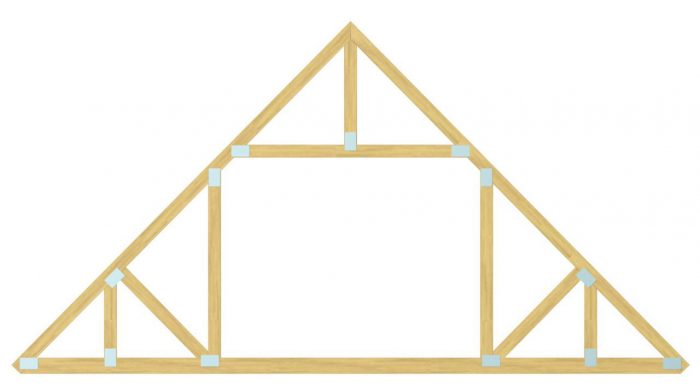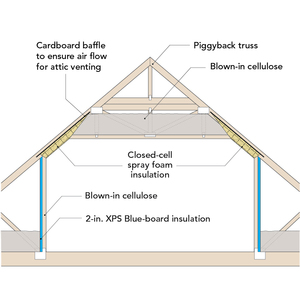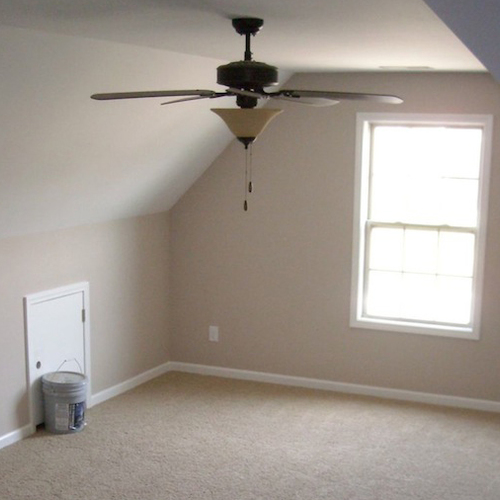
If your house has an attached garage, you may have a bonus room — that is, a bedroom above the garage. For new home builders, bonus rooms make sense: including one is relatively inexpensive for the builder, and it’s seen as a desirable feature by home buyers.
From a thermal or comfort perspective, however, most bonus rooms are disasters. They are often cold in winter and hot in summer, even when equipped with a supply register delivering conditioned air from a furnace or air conditioner. There are several reasons why this is so:
- A bonus room has more surfaces exposed to outdoor conditions than a typical room.
- Because of the need to address tricky air-sealing details at kneewalls, most bonus rooms have very leaky thermal envelopes.
- In homes with forced-air heating and cooling systems, the duct serving a bonus room is often undersized, poorly insulated, leaky, and unusually long.
Make sure you have an air barrier
In a new home, most builders use “room in attic” roof trusses to create a bonus room.

While these trusses simplify the framing details for construction workers, they have an Achilles’ heel: They lack a bottom plate under the kneewalls. The lack of a bottom plate complicates air sealing details and greatly increases the chance that the bonus room will have a leaky air barrier.
In most cases, the insulation contractors quickly stuff batts in the kneewalls, and then stuff batts in the joists separating the garage from the bonus room.
This photo shows the ceiling framing above a garage. The fiberglass batts installed in the bonus room kneewalls are hanging down into the joist bays. Needless to say, neither the framers nor the insulation crew thought to install an air barrier near the…
Weekly Newsletter
Get building science and energy efficiency advice, plus special offers, in your inbox.

This article is only available to GBA Prime Members
Sign up for a free trial and get instant access to this article as well as GBA’s complete library of premium articles and construction details.
Start Free TrialAlready a member? Log in















8 Comments
>"In other words, specify a minisplit that modulates down to 3,000 or 4,000 BTU/h under low-load conditions."
I'm sure there are bonus rooms that don't even hit 3000 BTU/hr even under DESIGN condition. There are enough 3/4 ton mini-splits with low enough minimums to make "under 2000 BTU/hr" the generic spec for the low end of the modulation range, even though 3-4000 wouldn't always be unreasonable.
Bonus Rooms are entirely the result of marketing. There is nothing inherently cheaper for either the builder, or if left unfinished the owner, about the construction of this space. They were the creature of a certain time, and I suspect will disappear.
or you could just closed cell spray foam in an unvented assembly. We had to totally gut our bonus room due to improper install of our insulation causing surface mold. We've decided just go with closed cell spray foam from top to bottom and close off the soffits and ridge vents. The added benefit is that we can now do built ins the full 35 foot length of our bonus room.
In most new construction homes, the bonus room floor as well as the floor of the home has R19 fiberglass batts placed on the bottom lip of a 16" I-beam and we know that this is doing absolutely nothing. There are a few installers that turn the end of the batt up but we also know this is not working. The final picture shows framing on 9" centers properly insulated with open cell foam.
Years ago, I used this picture of a neat fiberglass bonus room job that I had done myself in one of our brochures. Neatness doesn't help any the installation errors going on in this photo..
I'm designing a carriage house (ADU, aka garage with an apartment above it) in Detroit, climate zone 5A. It's got some fussy. details. I'm worried about moisture issues from condensation, and I could use some feedback.
The bedroom will have engineered attic trusses at 24" O.C. with built-in book cases between the vertical truss members of the knee wall. There garage below will be unconditioned and insulated. There is a thermal bridge in the garage at the water table. I've attached sheet showing a section through the space, and a similar detail that I'm using in another portion of the building.
I'm using Assembly #2: Vented assembly with fiberglass batts and interior rigid foam from the article: https://www.greenbuildingadvisor.com/article/five-cathedral-ceilings-that-work
From my understanding, the rigid needs to be taped and sealed along the perimeter to air seal it, preventing moist air from condensing on the bottom of the sheathing. In this particular room, the knee walls and cavities make sealing it tricky. In the drawing I'm calling for spray foam insulation to seal the additional penetrations. Does this work? Is there a better/simpler way to handle it? I don't think the contractor is going to like having to mess with the all the spray foam and I'm worried some will get missed.
Thanks for your help, in advance.
PS. I've read through these articles which have been helpful.
https://www.greenbuildingadvisor.com/article/how-to-build-an-insulated-cathedral-ceiling?oly_enc_id=0906G7453678A9E
https://www.greenbuildingadvisor.com/article/detailing-a-bonus-space-in-a-high-performance-home
Revo,
I notice that you have posted this question on two different pages. I answered you on the other page where you posted: https://www.greenbuildingadvisor.com/article/five-cathedral-ceilings-that-work#comment-267230
Sorry for the double post. I wasn't sure where to post to get the best chance of a reply.
Log in or become a member to post a comment.
Sign up Log in